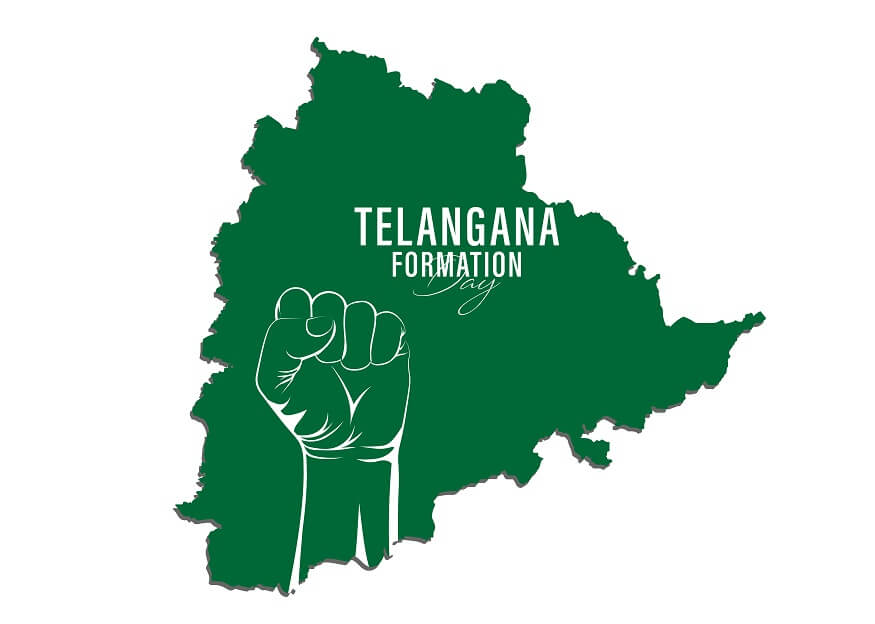Telangana Formation Day is an annual celebration that remembers the formation of the Indian state of Telangana on June 2nd, 2014. Before this date, Within the larger state of Andhra Pradesh, there existed a portion of it known as Telangana.
Telangana Formation Day underlines the fulfilment of a long-standing demand for separate statehood by the people of Telangana. The movement for Telangana’s statehood emerged due to concerns about economic neglect, cultural differences, and regional disparities within the combined state.
After years of protests, strikes, and political discussions, the Government of India accepted the Andhra Pradesh Changes Law of 2014, which led to the formation of Telangana as an independent state.
On Telangana Formation Day, various events and activities are organized across the state to celebrate this milestone. Flag-raising ceremonies, cultural performances, celebrations, exhibitions, and speeches on Telangana’s success and goals are frequently included in these events
Telangana Formation Day is significant because it honours the people of Telangana and their hope for independent regions and self-governance. It represents a time to consider the process of becoming a state, remember the sacrifices made, and honour Telangana’s unique culture and character.
Also Read: 7 Festivals in India for Children To Learn
Reason for Telangana formation:
The demand for a separate Telangana state was driven by several reasons and factors. Here are the main reasons behind the reorganization and the aspirations for an independent Telangana:
- Telangana was a part of Hyderabad’s royal kingdom before India’s independence, giving it a unique historical character. Telangana people were extremely proud of their own history and culture, which they thought separated them from the other states of Andhra Pradesh.
- Telangana region faced significant socio-economic disparities compared to the other regions of Andhra Pradesh. People felt that development needs were neglected, leading to issues such as a lack of infrastructure, inadequate investment, and unequal distribution of resources.
- Water resources, particularly the Krishna and Godavari rivers, were critical for agriculture in Telangana. The people of Telangana believed that the water distribution system favoured the Andhra region, leaving their farmers at a disadvantage.
- Telangana had a significant proportion of government jobs and educational institutions, but people felt that the opportunities were disproportionately allocated to individuals from other regions of Andhra Pradesh. This led to concerns about local employment and educational opportunities.
- Telangana’s people have a unique cultural and language identity, with their own music, dance, rituals, and a variant of the Telugu language. They desired to protect and develop their own traditions.
- Some believed that their political representation was not enough and that their opinions were not properly heard in decision-making processes. They believed that having a separate state would give them more control over their governance and policies.
- During the years, several social and political movements advocating for Telangana gained momentum. These efforts, led by entities like the Telangana Rashtra Samithi, were essential in turning over the people to the idea of a separate state.
In 2014, Andhra Pradesh was reorganised and Telangana was created as a separate state as a result of these causes coming together and the constant demands of the Telangana people.
History of Telangana:
Various dynasties and empires have called the area home, each leaving its mark on the environment and its people. This state was a part of the Mauryan empire, which was ruled by Emperor Ashoka in the third century. The region later came under the rule of the Satavahanas, Ikshvakus, and Vishnukundinas, among other dynasties.
In the medieval period, The Kakatiya dynasty, which ruled Telangana from the twelfth to the fourteenth centuries, came into popularity during this time. The Kakatiyas were known for their architectural prowess, and their capital, Warangal, became a centre of art, culture, and trade.
In the fourteenth century, the Delhi Sultanate expanded its rule over this state as a result of the Kakatiya defeat. The region saw a succession of Muslim rulers, including the Bahmani Sultanate and the Qutub Shahi dynasty. Golconda Fort, located in present-day Hyderabad, served as the capital of the Qutab Shahi kingdom.
In the late seventeenth century, after capturing Golconda, the Mughal Empire ruled Telangana directly. However, their control was not absolute, as local chieftains known as the Nizams gradually gained power and became semi-autonomous rulers under the Mughal suzerainty. The culture and history of Telangana have been greatly influenced by many years of Nizam rule in Hyderabad.
The Nizam of Hyderabad initially desired to maintain independence when India was freed from British control in 1947. Hyderabad finally progressed to participation in the Indian Union in 1948, however, thanks to its beneficial location and the government of India’s integrationist ambitions.
In the year 1956, there was an amalgamation that occurred whereby Andhra Pradesh swallowed up Telangana, consuming it completely. Nonetheless, with time the people dwelling within Telangana started to sense a lack of focus picked upon their domain in comparison to other regions situated inside Andhra Pradesh. Correspondingly so began an initiative that aimed at establishing a dissimilar sovereign state for just Telangana; this movement picked up velocity throughout the 1960s before finally concluding on June 2, 2014, as it arrived at successfully forming its own unique state. Today the pursuit persists- whilst striving for socio-economic progress along with developing itself further- as Telangana continues preserving its invaluable cultural inheritance- its narrative weaved together by both ancient kingdoms & dynasties alongside ambitions found within its populace pursuing localized identity & self-rule.
Significance of Telangana Day:
Also Read: History and Significance of Onam Festival
Here are some key points about the Significance of Telangana Day and its benefits.
Commemorates the Formation:
Telangana Day marks the anniversary of the formation of the state.
Celebrates Statehood:
It is a day of celebration for the people of Telangana as they attained statehood.
Fulfilment of Aspirations:
The formation of Telangana as a separate state represents the realisation of the long-standing aspirations of the people. The significance of Telangana Day lies in acknowledging the fulfilment of these aspirations and the empowerment of the region.
Cultural Identity:
Telangana Day highlights and promotes the unique cultural identity of the region.
Symbol of Progress:
It signifies the progress and development achieved by Telangana as an independent state.
Remembrance and Pride:
The anniversary of the state’s creation is commemorated on Telangana Day.
Unity and Togetherness:
Telangana Day brings the people of the state together, fostering unity and a sense of belonging.
Reflection and Renewal:
Telangana Formation Day is a time for reflection, introspection, and renewed commitment towards the progress and development of the state. The significance of Telangana Day lies in embracing achievements, learning from the past, and setting goals for the future.
For more such informative blogs, please visit EuroSchool website.











